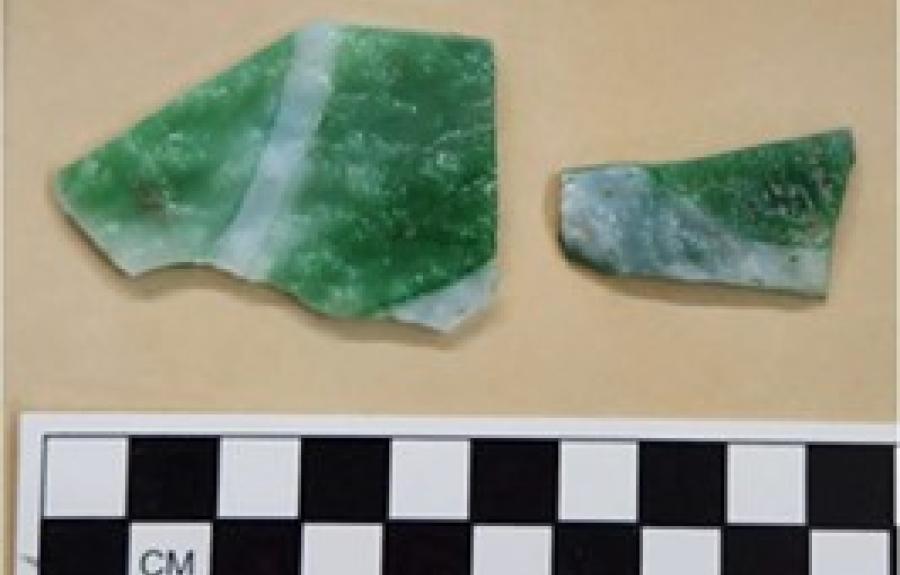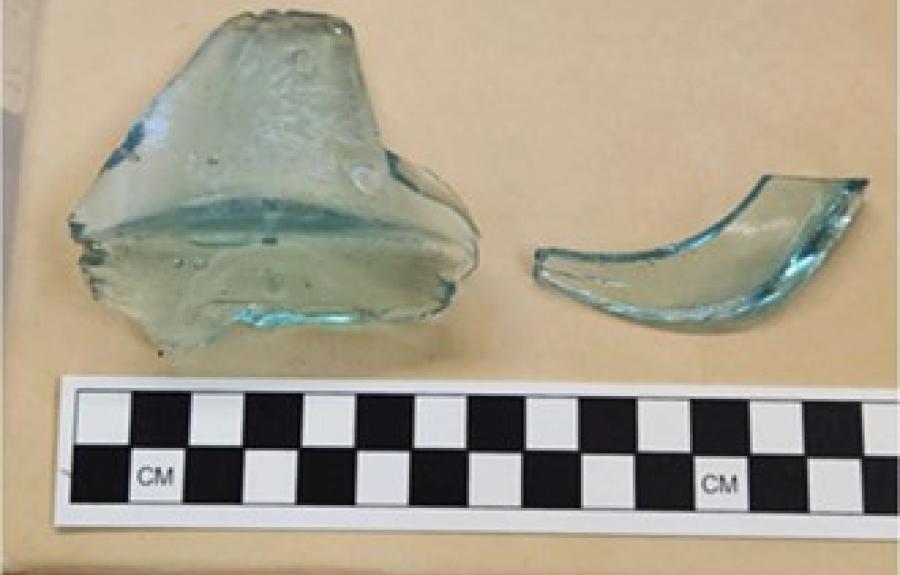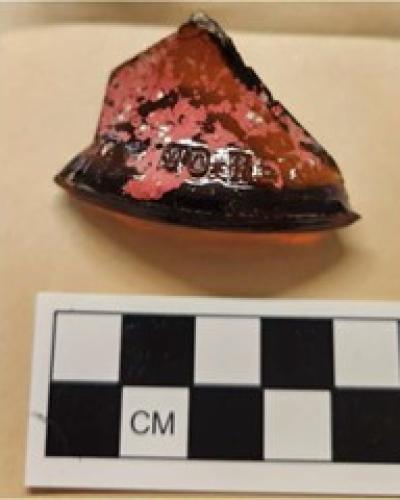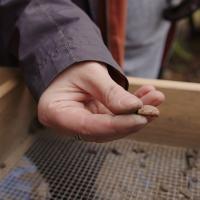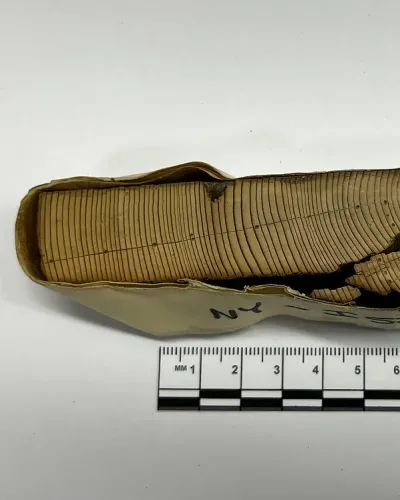The third season of community-engaged excavations at Ithaca’s St. James AME Zion Church, a pinnacle of Ithaca’s African American community for almost two centuries, is well underway! My experience three field days into the season plus time spent cataloguing and processing assorted artifacts in Cornell’s landscapes and objects laboratory have granted the privilege of familiarity with a multitude of recovered artifacts from the project’s lifespan: to kickstart the process of finer analysis of these artifacts for the greater community (in line with the project’s primary motivation), I below write briefly on a selection of glass artifacts from St. James in hopes of spurring further spirited engagement and discussion beyond the university’s limits.
Digging, screening, and bagging finds on Saturdays sets us up for washing, sorting, and cataloguing them during the week. It’s rather easy to become excited about artifacts as soon as we see them in the field, and I’ll admit that said excitement only blossoms as the artifacts are cleaned and in turn reveal to us additional details which dirt, sunlight, and other factors originally might have clouded. In the context of glass, colors shine more brightly, mold lines or other manufacturing marks appear more clearly, and embossed text or decorations surface more legibly, making for an interesting process of dialogue as even the smallest shards of glass share slices of their unique histories and experiences with a bunch of archaeologists.
As a general introduction, we have found glass used mostly for windows, bottles, and lamps/bulbs, although some one-off, harder to identify pieces may be remnants of items such as eyeglass lenses or automotive parts. Up to this point, window shards mostly are clear, tinted light blue-green, or glitter with a multicolored iridescence; bottle glass shards primarily come with amber, green, aqua, or clear tints; table glass pieces embossed or molded for aesthetic purposes largely look clear or light orange; and lamp or bulb glass fragments generally are transparent. Below, I highlight an assortment of glass fragments that stand out to me to share with readers near and far with an interest in and appreciation for St. James and its embedded community.
The vast majority of window shards from the St. James site are small, nondescript, flat, three- or four-sided, and transparent. The western parsonage, erected between 1898 and 1904, once stood somewhere on the lot where our excavation now occurs. It’s likely that at least some of the window glass relates to that structure, although the window glass pictured and discussed below, because of its vividly colorful stained design, probably comes from the church building itself, after 1945, when the church’s west-facing windows were redone with stained glass.
Clearly part of a larger stained glass item at one point, these pieces feel smooth on the reverse but bumpy on the obverse. My research into techniques of stained glass preparation enumerates different types of glass commonly used to form stained glass; these two pieces, based on coloration and texture, mostly likely fit into one of the following categories: Norman slab, crossed/pressed slab, or antique glass.[i] These three kinds vary in their respective blowing and flattening techniques—as I continue my research into these and other glass fragments over the duration of the academic semester, I hope to identify the most likely attribution for these stained fragments through additional analysis of their hues and surface textures. I plan to focus on thickness measurements, color tones, and preliminary luminescence analysis to develop a qualitative attribution within these three stained glass subcategories.
For now, what else can these two shards tell us? The distinct possibility exists that these pieces once formed a larger stained glass window on the church’s western wall. The finds come from unit 6, a one-square-meter unit on the northernmost third of the former parsonage’s lot. Unit 6, along with its isomorphic twin to the west, unit 5, most likely covers a midden feature. Accordingly, these shards may represent remnants of an older window on the church’s western wall; perhaps a few stray fragments escaped the coordinated disposal of an older window at some point during the later 20th century. Locus 6, the layer where these glass fragments lay before their removal on 10/29/2022, has an average depth of 52.9 cmbd (centimeters below datum, a depth-measurement system allowing for consistent measurements in relation to one predetermined datum point on our site—the point is fixed just northeast of the northeastern corner of unit 6). Approximately half a meter underground does not exactly qualify as shallow, and while we cannot say with certainty that a particular depth correlates to a fixed timeline at St. James (due to significant amounts of stratigraphic disturbance during construction, reconstruction, and destruction events of the parsonage), I will suggest that this depth of deposition probably indicates that these fragments date more closely to the time of the first stained glass usage at St. James in the mid-20th century. If, in my further research, any evidence for a firmer date emerges, I’ll be sure to update my post!
As noted above, window glass comprises just one subtype of glass found so far at St. James. Our finding of these beautifully-stained pieces is nothing short of fortuitous, since the other pieces of window glass are more homogeneous and less descriptive (or, at least less conducive to a formal analysis). I now shift to selections from our amassed arsenal of bottle glass, which usually tends to reveal information slightly more freely than does the subcategory of window glass. We have evidence at St. James for bottle glass across several time periods, as I aim to delineate in the following discussion.
The bottle glass from St. James mainly falls under the broader umbrella term of utilitarian glass, defined somewhat vaguely by the Society for Historical Archaeology (SHA) as single-use glass bottles not expected to return to their makers; heftier bottles designed by manufacturers for repeated usage; or, most generally, bottles circulated for use until discarded due to damage (in periods of time such as the early 1800s, when glass bottles were still relatively scarce).[ii] However, as we will see below, certain distinctive features of glass bottles allow for firmer typologies and date ranges.
I will consider first a set of light-blue bottle glass fragments, which we know to designate the same vessel due to identical color, texture, and thickness. In fact, we refer to one of these two fragments, the bottle’s base, as diagnostic, meaning that it conveys valuable information to archaeologists based on a certain intrinsic property. In this case, I’m referring to a pontil scar on the bottle’s base shard, pictured below. Pontil scars signify the final stage of bottle-blowing: after the glassblower has completed the bottle, the blowpipe, still affixed to the bottom of the shaped bottle, must be detached in a strong, swift motion.[iii] The presence of such a pontil scar on the bottle’s base confirms that this particular bottle was mouth-blown, not mold-blown, allowing us to date this object most likely to or before 1860, prior to the onset of the Civil War.[iv] Further evidence that a gaffer (glassblower) shaped this bottle through a mouth-blowing process lies in the presence of small air bubbles within the glass walls on the bottle’s base, visible below.
Specifically, we most likely are seeing what’s known as a blowpipe, open, or ring pontil, and two key observations on the fragment substantiate this identification: the rounded scar shape and the uniformly smooth surface across the bottom of the bottle both inside and outside the scar’s circumference (admittedly, I required tactile contact with the shard to verify the smoothness claim). According to the Society for Historical Archaeology, these two criteria come from a longer list compiled by Julian Harrison Toulouse at Iowa State University in a 1968 work on this topic.[v] Toulouse’s study offers the archaeologist and reader one additional piece of information that we may take at our own risk: we cannot be certain, but it is highly probable that, for bottles such as this one with visible blowpipe pontil scars, the shape and size of the pontil scar underneath the bottle closely mimics the dimensions of the bottle’s neck and top opening.[vi] No fragments of the bottle’s neck exist among our recovered artifacts to verify this proposition, unfortunately. Finally, in further research, I hope to create one or two scaled archaeological drawings for a crisper picture of the bottle’s original shape and dimensions, after which a more solidified identification might emerge regarding the bottle’s original purpose, e.g., liquor, water, medicine, etc.
As a reminder, utilitarian glass bottles would be discarded only after serious damage or breakage that would inhibit their usage and reusage; it’s very likely that this glass bottle saw significant reuse before an untimely disaster led to its disposal. The fragments above were recovered on 08/20/2021 in locus 5 of unit 1, a one-square-meter unit excavated in 2021 at the center of the yard’s north-south axis, and approximately one meter east of center along the east-west axis. The mean depth of Δ5 per our documentation would have been approximately 37 cmbd, by no means excessively deep, but definitely not shallow, either. Just to the south of unit 1 lies unit 2, another one-square- meter unit opened in 2021 and closed in 2022. From unit 2 locus 4, excavated on 10/02/2021, comes the final glass shard selected for this brief examination.
This final glass artifact is also diagnostic, not because of a pontil scar on its base, but rather due to visible text that reads “T […] NO RETU.” We know that this shard comes from a beer bottle and that the latter words originally read “NO RETURN” across the bottom; the initial T most likely concludes the phrase “NO DEPOSIT,” but fewer remaining letters challenge that identification. There is an indeterminate, possible maker’s mark between the “T” and the “N,” one aspect of this shard into which I hope to probe more deeply. Another further research topic specific to this artifact is its patterned discoloration, as visible in the figures below.
Of all the artifacts I’ve discussed in this analysis, thanks to this embossed text, we can assign a fairly narrow date range to this bottle. These ‘NO DEPOSIT’ bottles appeared from 1939 onward; furthermore, in 1939, manufacturers began to produce beer bottles with the text “NOT TO BE REFILLED // NO DEPOSIT – NO RETURN” embossed on the bottles’ shoulders (standard practice industry-wide by 1941).[vii] This glass fragment likely comes from the shoulder of one of these bottles, and while I hesitate to quantify the bottle’s dimensions and capacity without additional analysis, the strongest likelihood is that the bottle ranged from six to seven inches in height, and two to three inches in base diameter.[viii] SJ02Δ04, from where we recovered this shard, had a mean depth of 32.5 cmbd, slightly shallower on average than the depth at which the previous light-blue bottle glass artifacts originated.
The repeated processes of construction and destruction on the parsonage lot have melded together timelines in the history of St. James: older glass with a pontil scar and more recent glass with embossed text sat relatively close together in depth, although their respective dates of manufacture could have differed by almost one century. Stained glass, added to the church after the turn of the 20th century, lay fragmentarily in a midden feature, but much deeper than the bottle shards. To synthesize all this information, we can begin to imagine differing dumping practices both by church visitors and by parsonage residents: the midden in unit 5 possibly persisted as open yard space throughout the past and represented a natural dumping place, while the areas in which units 1 and 2 once lay would have been part of the parsonage building in a former age. On a concluding note, by the end of the 2022 excavation season, we had located remains of the parsonage’s foundation wall around a depth of 92 cmbd, granting near certainty that the parsonage once rose above that area. It’s not too difficult to imagine glass falling and shattering onto the floor of a residence, shards finding their ways to corners or hidden areas beneath furniture items and only coming to light much later, or any other number of ways that these broken pieces of glass survived decades and centuries to today.
[i] “The History, Purpose, and Techniques of Stained Glass Windows - Londonhua WIKI,” accessed October 1, 2023, https://londonhuawiki.wpi.edu/index.php/The_History,_Purpose,_and_Techniques_of_Stained_Glass_Windows.
[ii] “Bottle Glossary Page,” accessed October 2, 2023, https://sha.org/bottle/glossary.htm#Utilitarian%20Bottles.
[iii] “Pontil Scars,” accessed October 3, 2023, https://sha.org/bottle/pontil_scars.htm#Blowpipe%20Pontil%20scar.
[iv] “Pontil Scars,” accessed October 3, 2023, https://sha.org/bottle/pontil_scars.htm#Blowpipe%20Pontil%20scar.
[v] “Pontil Scars,” accessed October 3, 2023, https://sha.org/bottle/pontil_scars.htm#Blowpipe%20Pontil%20scar.
[vi] “Pontil Scars,” accessed October 3, 2023, https://sha.org/bottle/pontil_scars.htm#Blowpipe%20Pontil%20scar.
[vii] Schulz, Peter, Bill Lockhart, Carol Serr, Bill Lindsey, and Beau Schriever. “A History of Non- Returnable Beer Bottles,” n.d.
[viii] Schulz, Peter, Bill Lockhart, Carol Serr, Bill Lindsey, and Beau Schriever. “A History of Non- Returnable Beer Bottles,” n.d.

